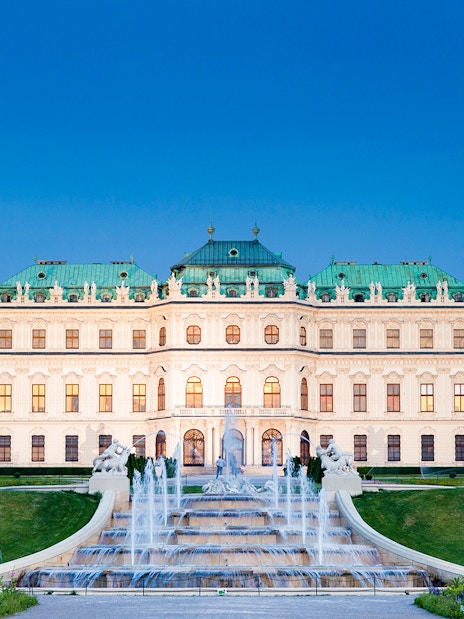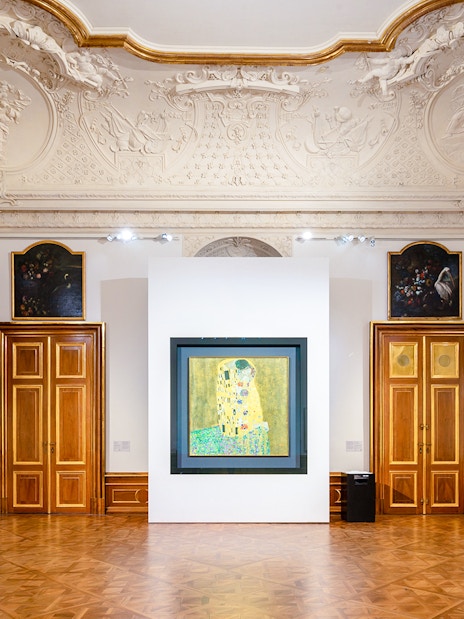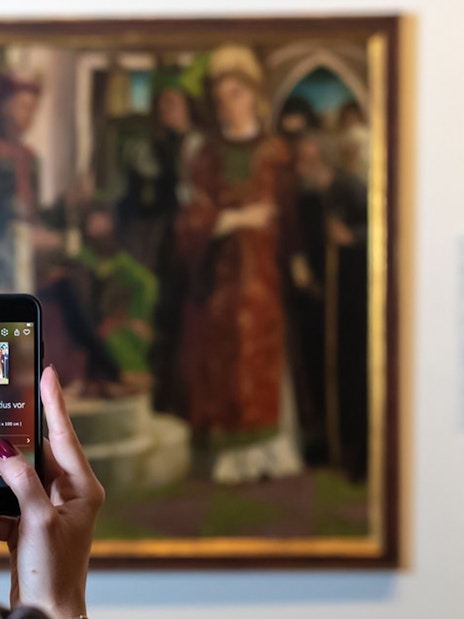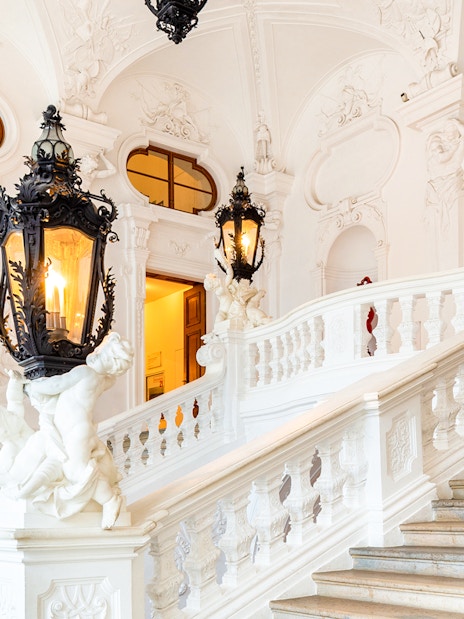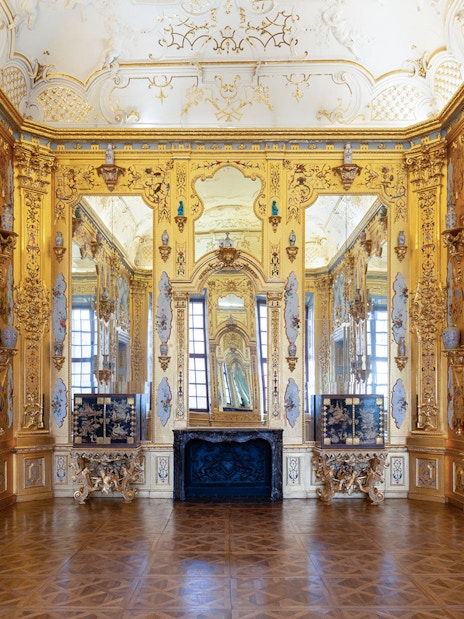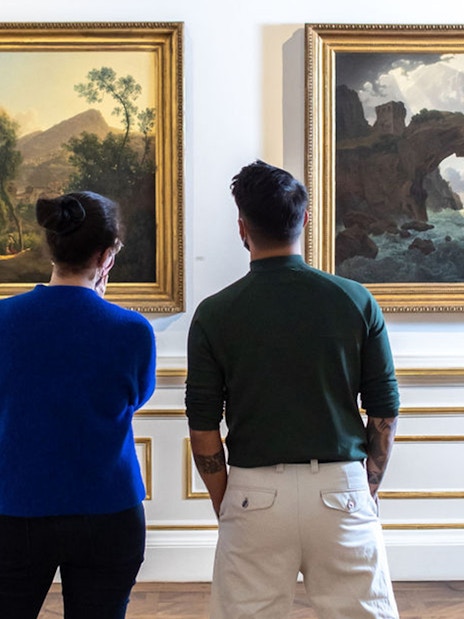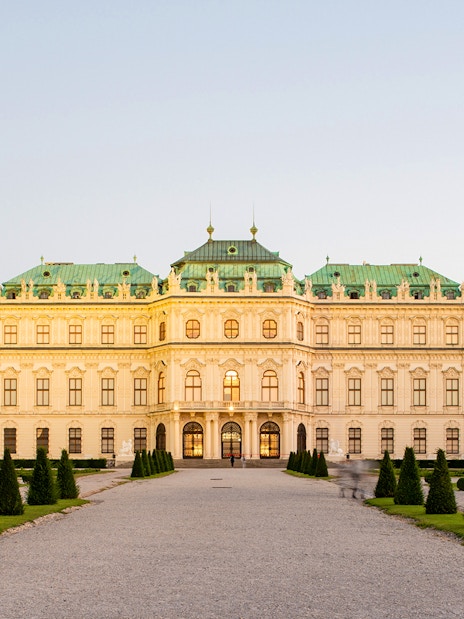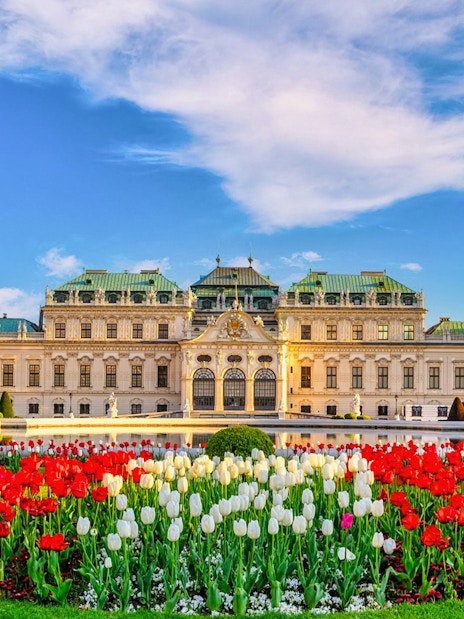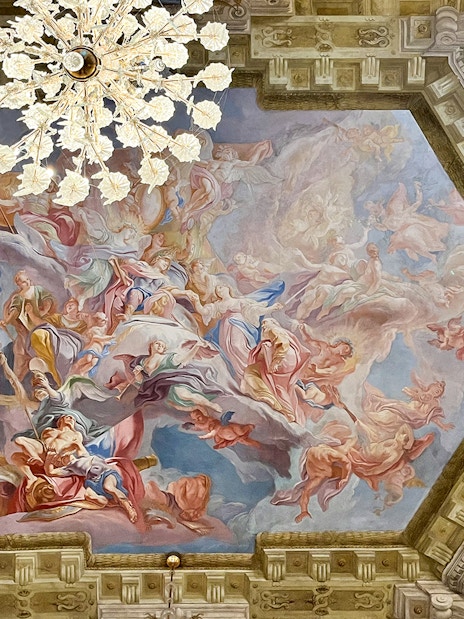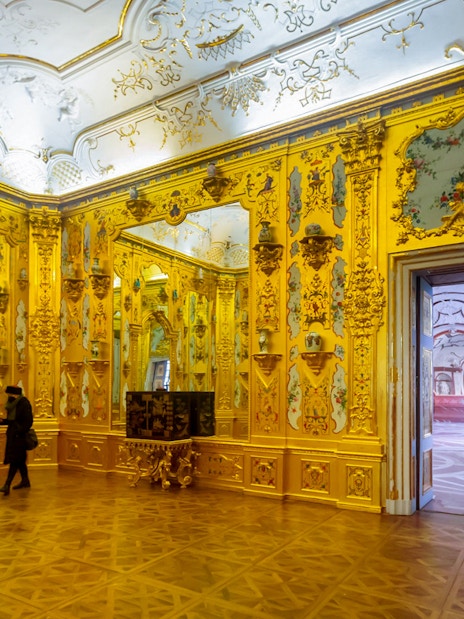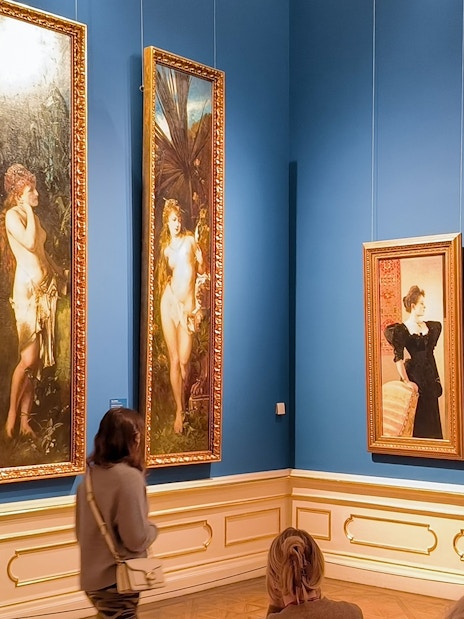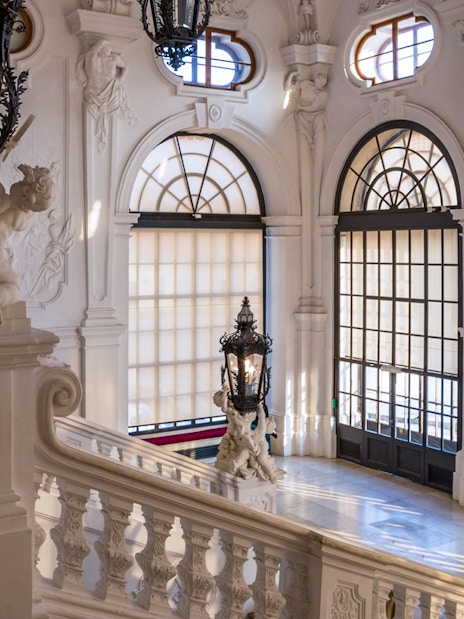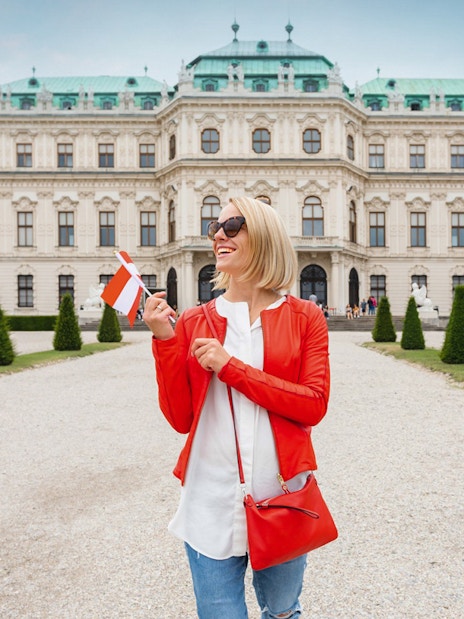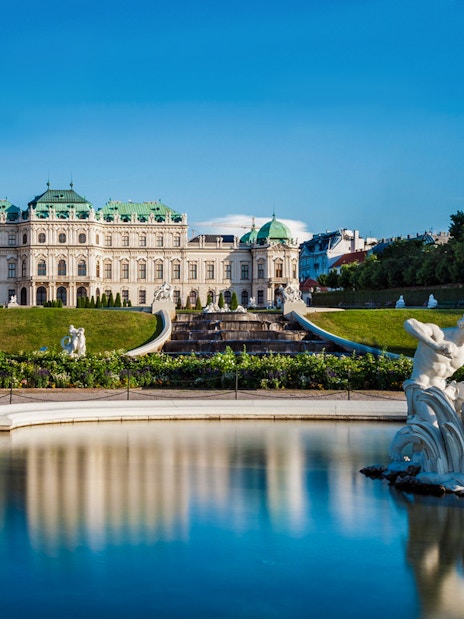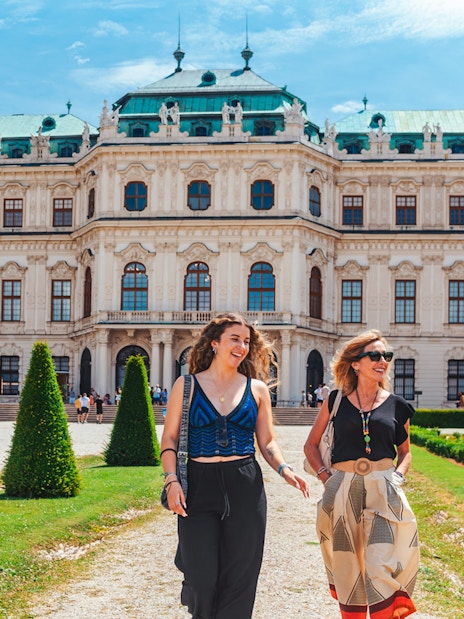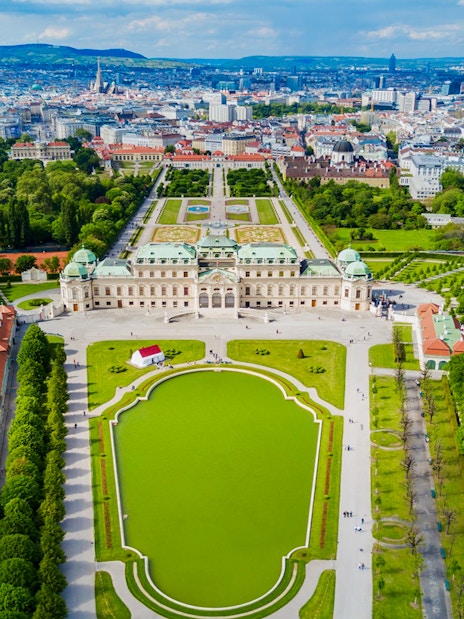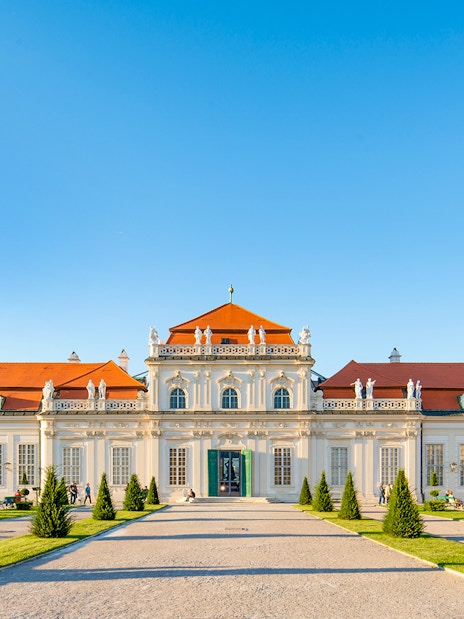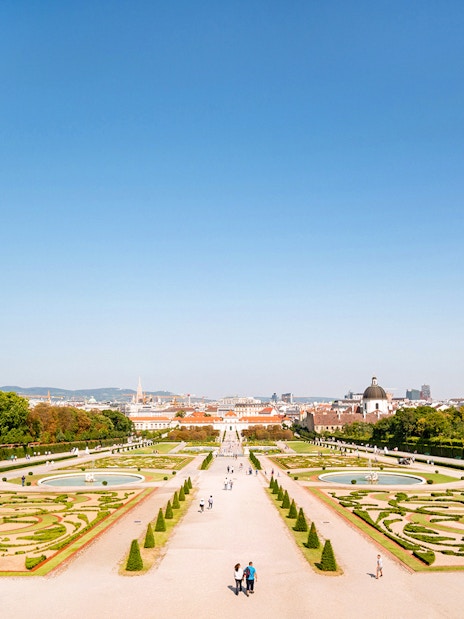- Light of Creation
- Schönbrunn Palace
- Schönbrunn Zoo
- Kunsthistorisches Museum Vienna Tickets
- Vienna Giant Ferris Wheel
- Albertina Museum Vienna
- Mozarthaus Vienna
- Leopold Museum
- Museum of Illusions
- Imperial Carriage Museum Vienna
- Sigmund Freud Museum Tickets
- Imperial Treasury Vienna
- Chocolate Museum Vienna
- MAK - Museum of Applied Arts
- Big Bus Vienna Hop-on Hop-off Tours
Upper Belvedere Palace Tickets
Headout is an authorized and trusted partner of the venue, offering curated experiences to enjoy this attraction. This is not the venue's website.

- Visit the UNESCO-listed Belvedere Palace in Vienna with access to the Upper Belvedere’s temporary and permanent exhibitions.
- Skip the snaking lines at the ticket counter and delve into the works of Gustav Klimt such as the iconic painting ‘The Kiss.’
- Discover paintings, sculptures, and Gothic winged altars by artists like Vincent van Gogh, Claude Monet, and Auguste Rodin in the permanent collection.
- Encounter the works of prominent artists in the interwar period in Central Europe such as László Moholy-Nagy, František Kupka, and more.
- With a ticket upgrade, get the royal treatment with skip-the-line entry, access to the Belvedere Gardens, and a tour with a licensed guide.
- Visit the UNESCO-listed Belvedere Palace in Vienna with access to the Upper Belvedere’s temporary and permanent exhibitions.
- Skip the snaking lines at the ticket counter and delve into the works of Gustav Klimt such as the iconic painting ‘The Kiss.’
- Discover paintings, sculptures, and Gothic winged altars by artists like Vincent van Gogh, Claude Monet, and Auguste Rodin in the permanent collection.
- Encounter the works of prominent artists in the interwar period in Central Europe such as László Moholy-Nagy, František Kupka, and more.
- With a ticket upgrade, get the royal treatment with skip-the-line entry, access to the Belvedere Gardens, and a tour with a licensed guide.
Inclusions
- Entry to Upper Belvedere
- Access to Klimt's 'The Kiss'
- Access to the permanent collection
- Skip-the-line entry to Upper Belvedere (main exhibition) (based on the option selected)
- Guided tour of Upper Belvedere Art Gallery & Belvedere Palace Gardens (based on the option selected)
- 5-star licensed English-speaking guide (based on the option selected)
- Entry into Belvedere Gardens (based on the option selected)
Exclusions
- Audio guide (available for purchase on-site)
- Tip: Go around to the front of Upper Belvedere, and walk out beyond the small lake to take some excellent photos of the palace.
- This experience is wheelchair accessible.
- Your guide dogs are welcome at the venue.
- With this ticket, skip the line to the ticket counter/box office and head straight to the museum entrance!
- Suitcases and large bags are not allowed in the museum and cannot be left in the cloakroom.
- The parking lot for people with disabilities is located right next to the entrance gate of the Upper Belvedere, Prinz Eugen-Straße 27.
- Note: With your time slot ticket you book a fixed access time to the museum. The duration of your stay is unlimited.
- 2024-2025 Exhibition Highlights
- March 27, 2025 to October 19, 2025: CARLONE CONTEMPORARY: Sarah Ortmeyer
- May 15, 2025 to October 5, 2025: IM BLICK: Gustav Klimt: The Bride
- You can cancel these tickets up to 24 hours before the experience begins and get a full refund.
Reviews
How do we collect reviews?
Snapshots from our guests
4.5
6,876 ratings
4.0K
2.2K
413
94
110
What our guests say
Sophie
Jun 2025Verified booking
Very easy to book and pay and all went well at the visit, which was a wonderful experience, loved the Belvedere and the glorious paintings there, including of course The Kiss!
Mary
Jun 2025Verified booking
The gallery was amazing especially the iconic Klimt. The bonus was the beautiful palace where the paintings were displayed. The gardens too were a beautiful stroll.
Lachkoul
May 2025Verified booking
Exceptional paintings. Magnificent museum! Very well maintained park and museum, very professional and pleasant staff.
View original review in French
TONIA
May 2025Verified booking
The Upper Belvedere Castle is well worth seeing. In addition to the well-kept interior and jordium, extraordinary works by Klimt (including The Kiss) and others are admired. Easily reached by streetcar.
View original review in Italian
Dace
May 2025Verified booking
Ticketing experience was great and convenient.I truly enjoyed not to queue in a long line.Having combo ticket was also great because I could enjoy both Lower and Upper Belvedere save the time , plan my day and enjoy Belvedere.
Mira
Apr 2025Verified booking
Ticket purchase was hassle free. Wish there weren't ticket charges for separate parts of the tour! Palace tour was awesome!
LUANA
Apr 2025Verified booking
Tickets purchased online so we avoided lines, beautiful museum, well organized, elegant and with possibility to purchase audio guide on site at a cost of €.5
View original review in Italian
Vincenzo
Apr 2025Verified booking
Excellent advance organization for ticket issuance. Immediate entry despite long lines. For the inside part all quiet.
View original review in Italian
Testa
Apr 2025Verified booking
A magnificent, must-see place in Vienna! There are priceless works to be seen. For the wire-cut tickets, it was indicated that they had to be exchanged. In the end, exchange was not necessary. It's important to keep to the timetable. We booked for 10:30 and couldn't get in before then. Nice experience.
View original review in French
Eleni
Apr 2025Verified booking
I was delightfully surprised that there was no queue and I could get inside at the time I had booked! The palace is amazing and the exhibition is totally captivating !
CELLE
Jun 2025Verified booking
Enjoy Austrian art from the 1900s.
View original review in French
TROTTA
Jun 2025Verified booking
All very well it was a unique experience
View original review in Italian
Tina
Jun 2025Verified booking
Booking was so easy and our guide Alex was so knowledgeable! He obviously loves his job and is passionate about art.
Rosaria
Jun 2025Verified booking
You can visit Upper Belvedere with no problems at all. Reserve the slot you prefer and enjoy Klimt's Kiss
Jeanne
May 2025Verified booking
Unexpected, large piece of land preserved in the city, easy to get to using the tram
Ronald
May 2025Verified booking
Easy and flexible time Easy to locte the place and not so crowded
Arianna
May 2025Verified booking
The highlight of my visit was seeing the works of klimt. unique emotion
View original review in Italian
ERCOLE
May 2025Verified booking
Avoided lines and saved significantly. Experience to be repeated
View original review in Italian
Jerome
May 2025Verified booking
Lovely building and museum Make sure you approach museum through magnificent gardens
ANGELIKI
Apr 2025Verified booking
It was all perfect and beautiful!!! And clean!!! I recommend a good sneaker because there is a lot of walking!!!
This review is translated. Show original review.
Luana
Apr 2025Verified booking
We loved everything!!!!!!!!!!!!!!!!!!!!!
Tamiris
Apr 2025Verified booking
The palace is impressive and full of beautiful works of art and I finally got to see my favorite painting : The Kiss
View original review in Portuguese
Allyson
Apr 2025Verified booking
Very beautiful! Easy to get tickets! We loved touring this palace.
Van
Apr 2025Verified booking
Nice museum with beautiful garden. Purchased tickets on the internet and was able to walk right through.
View original review in Dutch
Cerra
Apr 2025Verified booking
Virtually everything, Klimt's kiss in particular.
View original review in Italian
Combos
Combo (Save 8%): Direct Entry Tickets to Upper and Lower Belvedere Palace
from €39
€35.88
8% off
- Cover both the Upper and Lower Belvedere Palace at a bargain price with this direct entry combo ticket that lets you skip the long lines at the ticket counter!
- Immerse yourself in a world of Baroque beauty, from marble halls to manicured gardens in the Upper Belvedere Palace.
- Discover a range of artistic masterpieces, from Gustav Klimt's The Kiss, to pieces by Van Gogh and Egon Schiele.
- Soak in the grandeur of the building's Baroque architecture and admire the 430 artworks spanning 800 years of art history.
- Explore the Lower Belvedere Palace, originally built for Prince Eugene as a residential building.
- Marvel its staterooms that illustrate the Baroque lifestyle and craftsmanship.
- Tour The Hall of Grotesques, The Gold Cabinet, The Marble Gallery, and more fascinating rooms.
- The Baroque gardens between the Upper and Lower Belvedere are ranked among the most beautiful in the world.
- Cover both the Upper and Lower Belvedere Palace at a bargain price with this direct entry combo ticket that lets you skip the long lines at the ticket counter!
- Immerse yourself in a world of Baroque beauty, from marble halls to manicured gardens in the Upper Belvedere Palace.
- Discover a range of artistic masterpieces, from Gustav Klimt's The Kiss, to pieces by Van Gogh and Egon Schiele.
- Soak in the grandeur of the building's Baroque architecture and admire the 430 artworks spanning 800 years of art history.
- Explore the Lower Belvedere Palace, originally built for Prince Eugene as a residential building.
- Marvel its staterooms that illustrate the Baroque lifestyle and craftsmanship.
- Tour The Hall of Grotesques, The Gold Cabinet, The Marble Gallery, and more fascinating rooms.
- The Baroque gardens between the Upper and Lower Belvedere are ranked among the most beautiful in the world.
Inclusions
Upper Belvedere Palace
- Entry to the Upper Belvedere
Lower Belvedere Palace
- Entry to the Lower Belvedere
Upper Belvedere Palace
- Entry to the Upper Belvedere Palace is scheduled according to specific time slots. Guests are required to arrive during their chosen time slot in order to gain access.
- Please ensure approximately 2 hours between your chosen time slots to the Upper and Lower Belvedere for a smooth experience
- Audio guides are available at the ticket counter in German, English, French, Italian, Russian, Japanese, Korean, Spanish, Mandarin, Cantonese, and Ukrainian.
- Rental fees: Permanent collection tour €5.00.
- For reasons of hygiene, we ask you to use personal headphones (standard 3.5 mm connection). As an alternative, disposable headphones are provided.
- Please note that the Austrian sign language multimedia guides are only available free of charge on YouTube as videos on your mobile phone. A new edition of the multimedia guides is still being worked on.
- Note: With your time slot ticket, you book a fixed access time to the museum. The duration of your stay is unlimited.
Lower Belvedere Palace
- An audio guide is available at the ticket counter in German and English, only for selected temporary exhibitions.
- Rental fees: €5 on site and also on Smartify.
- For reasons of hygiene, we ask you to use personal headphones (standard 3.5 mm connection). As an alternative, disposable headphones are provided.
- Note: With your time slot ticket, you book a fixed access time to the museum. The duration of your stay is unlimited.
- You can cancel these tickets up to 24 hours before the experience begins and get a full refund.
Reviews
How do we collect reviews?
Snapshots from our guests
4.4
7,042 ratings
4.1K
2.3K
442
103
148
What our guests say
Sophie
Jun 2025Verified booking
Very easy to book and pay and all went well at the visit, which was a wonderful experience, loved the Belvedere and the glorious paintings there, including of course The Kiss!
Mary
Jun 2025Verified booking
The gallery was amazing especially the iconic Klimt. The bonus was the beautiful palace where the paintings were displayed. The gardens too were a beautiful stroll.
Lachkoul
May 2025Verified booking
Exceptional paintings. Magnificent museum! Very well maintained park and museum, very professional and pleasant staff.
View original review in French
TONIA
May 2025Verified booking
The Upper Belvedere Castle is well worth seeing. In addition to the well-kept interior and jordium, extraordinary works by Klimt (including The Kiss) and others are admired. Easily reached by streetcar.
View original review in Italian
Dace
May 2025Verified booking
Ticketing experience was great and convenient.I truly enjoyed not to queue in a long line.Having combo ticket was also great because I could enjoy both Lower and Upper Belvedere save the time , plan my day and enjoy Belvedere.
Mira
Apr 2025Verified booking
Ticket purchase was hassle free. Wish there weren't ticket charges for separate parts of the tour! Palace tour was awesome!
Michaela
Apr 2025Verified booking
It was an all-round successful trip, unfortunately it rained, but you can't influence that... Worth seeing and highly recommended....
View original review in German
LUANA
Apr 2025Verified booking
Tickets purchased online so we avoided lines, beautiful museum, well organized, elegant and with possibility to purchase audio guide on site at a cost of €.5
View original review in Italian
Vincenzo
Apr 2025Verified booking
Excellent advance organization for ticket issuance. Immediate entry despite long lines. For the inside part all quiet.
View original review in Italian
Testa
Apr 2025Verified booking
A magnificent, must-see place in Vienna! There are priceless works to be seen. For the wire-cut tickets, it was indicated that they had to be exchanged. In the end, exchange was not necessary. It's important to keep to the timetable. We booked for 10:30 and couldn't get in before then. Nice experience.
View original review in French
Eleni
Apr 2025Verified booking
I was delightfully surprised that there was no queue and I could get inside at the time I had booked! The palace is amazing and the exhibition is totally captivating !
CELLE
Jun 2025Verified booking
Enjoy Austrian art from the 1900s.
View original review in French
TROTTA
Jun 2025Verified booking
All very well it was a unique experience
View original review in Italian
Rosaria
Jun 2025Verified booking
You can visit Upper Belvedere with no problems at all. Reserve the slot you prefer and enjoy Klimt's Kiss
Jeanne
May 2025Verified booking
Unexpected, large piece of land preserved in the city, easy to get to using the tram
Ronald
May 2025Verified booking
Easy and flexible time Easy to locte the place and not so crowded
Arianna
May 2025Verified booking
The highlight of my visit was seeing the works of klimt. unique emotion
View original review in Italian
ERCOLE
May 2025Verified booking
Avoided lines and saved significantly. Experience to be repeated
View original review in Italian
Jerome
May 2025Verified booking
Lovely building and museum Make sure you approach museum through magnificent gardens
ANGELIKI
Apr 2025Verified booking
It was all perfect and beautiful!!! And clean!!! I recommend a good sneaker because there is a lot of walking!!!
This review is translated. Show original review.
Luana
Apr 2025Verified booking
We loved everything!!!!!!!!!!!!!!!!!!!!!
Tamiris
Apr 2025Verified booking
The palace is impressive and full of beautiful works of art and I finally got to see my favorite painting : The Kiss
View original review in Portuguese
Allyson
Apr 2025Verified booking
Very beautiful! Easy to get tickets! We loved touring this palace.
Van
Apr 2025Verified booking
Nice museum with beautiful garden. Purchased tickets on the internet and was able to walk right through.
View original review in Dutch
Cerra
Apr 2025Verified booking
Virtually everything, Klimt's kiss in particular.
View original review in Italian
Explore art and history on a guided Upper Belvedere tour—no lines, just masterpieces.
- Everything you get: Skip-the-line access and a comprehensive 1.5-hour guided tour of the Upper Belvedere Palace’s art gallery and Baroque gardens with fountains and sculptures, in a language of your choice. This includes the Marble Hall where the Austrian State Treaty was signed in 1955.
- Why choose this: This tour gives you personalized insights into famous paintings like Klimt’s The Kiss and masterpieces by Egon Schiele, Oskar Kokoschka, Vincent van Gogh, and Claude Monet.
Explore art and history on a guided Upper Belvedere tour—no lines, just masterpieces.
- Everything you get: Skip-the-line access and a comprehensive 1.5-hour guided tour of the Upper Belvedere Palace’s art gallery and Baroque gardens with fountains and sculptures, in a language of your choice. This includes the Marble Hall where the Austrian State Treaty was signed in 1955.
- Why choose this: This tour gives you personalized insights into famous paintings like Klimt’s The Kiss and masterpieces by Egon Schiele, Oskar Kokoschka, Vincent van Gogh, and Claude Monet.
Inclusions
- Guided tour of Upper Belvedere Art Gallery & Belvedere Palace Gardens
- English/Spanish/Italian-speaking guide
- Skip-the-line entry to Upper Belvedere (main exhibition)
- Admission to Belvedere Gardens
Exclusions
- Entry to optional & temporary exhibitions
- This experience is wheelchair accessible.
- Your guide dogs are welcome at the venue.
- Accessible parking spaces are conveniently located right next to the entrance gate of the Upper Belvedere, Prinz Eugen-Straße 27.
- You can enter the palace at the time slot you choose while booking your ticket. Once inside, you can stay and explore as long as you wish.
- Lockers and a cloakroom are available to store your personal belongings. These cannot accommodate large bags or luggage.
- You can cancel these tickets up to 24 hours before the experience begins and get a full refund.
Reviews
How do we collect reviews?
Snapshots from our guests
4.5
295 ratings
169
108
7
5
6
What our guests say
Tina
Jun 2025Verified booking
Booking was so easy and our guide Alex was so knowledgeable! He obviously loves his job and is passionate about art.
Silvio
Jun 2025Verified booking
Our guide, Germana, was very friendly and professional. She provided a wealth of information about Klimt's and Schiele's masterpieces and their lives. I loved her. Thank you again
Malcolm
Jun 2025Verified booking
Our art historian tour guide was amazing and so incredibly knowledgeable that we learned so much and truly enjoyed the whole experience!
linda
May 2025Verified booking
As instructed. we arrived 15 minutes early to commence the tour at 11am. Once the tour guide collected the entry tickets, we finally entered the Upper Belvedere Palce to commence the guided tour of the art gallery at 11.45am. The tour guide was very quietly spoken and at times difficult to hear Very dissapointing content Poor value for money
Giliola
May 2025Verified booking
The guide Mr. Raffaele very knowledgeable never boring , with him we also visited Schönbrunn, same preparation, very nice. Grazt
View original review in Italian
Narguess
May 2025Verified booking
Anna was a wonderful guide, extremely knowledgeable and friendly. She gave us so much information about the history and people who lived in the palace. Not to be missed. Thank you
Catherine
May 2025Verified booking
Guide was fine but group was large (17 I think.) We would prefer smaller group. Perhaps let people know before booking what size to expect. Also, there were some we had to wait for all the time.
TINA
May 2025Verified booking
Our guide was very entertaining and knowledgeable. There were so many visitors, the venue was crowded, but we were glad to have the skip-the-line feature. So historical, the gardens are so vast.
Anna
Apr 2025Verified booking
Exceptional! Guided tour to the Upper Belvedere - Vienna We quickly found our guide, Otilia, who turned out to be a knowledgeable, kind and very helpful professional. She took us with great passion through the halls of the museum, making us dwell on some particularly significant works and carefully describing them, even dwelling on details that we probably would have ignored on our own. A truly enjoyable and interesting experience, which I highly recommend to anyone who wants to visit the Belvedere with a knowledgeable and passionate guide.
View original review in Italian
Julie
Apr 2025Verified booking
Great tour. Easy joining instructions and brilliant guide (Alex). Would highly recommend as the best way to visit this beautiful palace
Marija
Apr 2025Verified booking
Our guide Dieter was fantastic. Attentive to the group, speaking slowly and clearly, providing interesting stories, linking history, art, architecture, artists' lives etc. Knows a lot and pasinate about what he does. The audio headphones were really useful, we could hear Dieter easily all the time. My family enjoyed this experience and thank you once again for the unforgettable visit.
Manuela
Apr 2025Verified booking
The guide who accompanied us made for a wonderful experience. Alex guided us through the history of the palace and the works of art it holds with passion, and professionalism.
View original review in Italian
Alvida
Jun 2025Verified booking
Amazing tour ! Our guide was knowledgeable and took time explaining ! Wow it was great ! Yes ! Yes ! Yes ! We loved it !
Nicole
Jun 2025Verified booking
The guide was really fascinating and passionate about art, and the visit was very interesting.
View original review in French
C
Jun 2025Verified booking
The tour was great Good explanations and anecdotes... We understand history better with him.
View original review in French
Gunnar
May 2025Verified booking
Very easy to book tickets and excellent information before we left. Skilled and friendly guide
This review is translated. Show original review.
Marco
May 2025Verified booking
I loved that we skiped the lines. And everything started and ended on time.
Anna
May 2025Verified booking
The English guided tour was very good.
Olga
May 2025Verified booking
Great experience! The tour was very informative – we walked away with a lot of new knowledge.
Anja
May 2025Verified booking
Your guide Mirko is very good. He told interesting stories and details about the paintings and the palace.
Basak
May 2025Verified booking
The guides were awesome! Loved the tour.
Zaira
May 2025Verified booking
The guidance was outstanding!!!!!
View original review in Italian
Sara
Apr 2025Verified booking
Easy ticket purchase!!! Beautiful experience and magnificent places ☺️
View original review in Italian
Salvatore
Apr 2025Verified booking
Bravissimo the guide!!! Congratulations.Thank you! Patrizio Mongiardo and Cesaro Anna .
View original review in Italian
LAURA
Apr 2025Verified booking
Our guide Stephen really knowledgeable and nice. The palace magnificent and unique!
View original review in Italian
- Enjoy access to the Lower Belvedere Palace, a UNESCO World Heritage Site with impressive Baroque architecture and interiors.
- Explore works by Austrian artists inside and follow the key movements in Western art history.
- Enter the Hall of Grotesques and see a variety of painted grotesques on walls and ceilings.
- Admire the Marble Hall, whose floors and walls are all marble, are interlaced with stucco reliefs.
- Step into the Gold Cabinet, home to gold walls, giant mirrors, and grotesque paintwork.
- Pick from a 1, 2, 3, or 6-day Vienna Pass to enjoy fast-track entry to 70+ attractions, unlimited HOHO bus rides with a free guidebook, and city map.
- Enjoy access to the Lower Belvedere Palace, a UNESCO World Heritage Site with impressive Baroque architecture and interiors.
- Explore works by Austrian artists inside and follow the key movements in Western art history.
- Enter the Hall of Grotesques and see a variety of painted grotesques on walls and ceilings.
- Admire the Marble Hall, whose floors and walls are all marble, are interlaced with stucco reliefs.
- Step into the Gold Cabinet, home to gold walls, giant mirrors, and grotesque paintwork.
- Pick from a 1, 2, 3, or 6-day Vienna Pass to enjoy fast-track entry to 70+ attractions, unlimited HOHO bus rides with a free guidebook, and city map.
Inclusions
- Admission tickets to Lower Belvedere
- Tip: The Belvedere has a well-stocked gift shop where you can buy souvenirs such as jewelry, clothes, books, art collections, stationary, home decor, and more.
- With this ticket, you can directly head to the counter/box office and head straight to the museum entrance!
- Suitcases and large bags are not allowed in the museum and cannot be left in the cloakroom.
- The BIP garage at Palais Schwarzenberg and the BIP garage at Schwarzenbergplatz offer discounted parking for a time window of 6 hours. When you validate your parking ticket at the ticket offices of the Lower or Upper Belvedere (see opening times), you can park for up to 6 hours for € 6 in one of the two garages that are open all day (midnight).
- Note: With your time slot ticket you book a fixed access time to the museum. The duration of your stay is unlimited.
- 2024-2025 Exhibition Highlights
- February 20, 2025 to September 7, 2025: Gustav Klimt. Pigment & Pixel
- June 18, 2025 to October 12, 2025: RADICAL! Women Artists and Modernism 1910−1950
- September 25, 2025 to February 8, 2026: Cézanne, Monet, Renoir. French Impressionism from the Museum Langmatt
- October 31, 2025 to March 8, 2026: Franz Xaver Messerschmidt – More than Character Heads
- You can cancel these tickets up to 24 hours before the experience begins and get a full refund.
Reviews
How do we collect reviews?
Snapshots from our guests
4.1
441 ratings
220
128
36
13
44
What our guests say
Michaela
Apr 2025Verified booking
It was an all-round successful trip, unfortunately it rained, but you can't influence that... Worth seeing and highly recommended....
View original review in German
Robbe
Jun 2025Verified booking
The wonderful building, the ceilings but little interest in the painting exhibition.
View original review in French
Michael
May 2025Verified booking
What I loved the most about this place was display
Laura
May 2025Verified booking
Useful to avoid ticket line at entrance.
Silke
Apr 2025Verified booking
Great exhibition, great location
View original review in German
Lynn
Jun 2025Verified booking
Wetzel
Jun 2025Verified booking
Claudia
Jun 2025Verified booking
Robert
Jun 2025Verified booking
Nico
Jun 2025Verified booking
Giulia
May 2025Verified booking
Sean
May 2025Verified booking
Giovannella
May 2025Verified booking
Birgit
May 2025Verified booking
Tabarcea
May 2025Verified booking
DIMITAR
May 2025Verified booking
Christos
May 2025Verified booking
Denise
May 2025Verified booking
Floca
May 2025Verified booking
Carolin
Apr 2025Verified booking
Marta
Apr 2025Verified booking
Van
Apr 2025Verified booking
Richa
Apr 2025Verified booking
François
Apr 2025Verified booking
Gulin
Apr 2025Verified booking
Visit 2 to 5 top attractions in Vienna at budget-friendly rates – save up to 30%!
- Everything you get: Access to 2/3/4/5 attractions from a list of 60+ top sights in the city. You can enjoy a hassle-free sightseeing experience at Schönbrunn Palace, Schönbrunn Zoo, Sisi Museum Hofburg, and other landmarks for a reasonable price.
- Why choose this: You can save up to 30% and forget the hassle of purchasing multiple tickets and enjoy smooth entry to attractions with just one physical pass.
Visit 2 to 5 top attractions in Vienna at budget-friendly rates – save up to 30%!
- Everything you get: Access to 2/3/4/5 attractions from a list of 60+ top sights in the city. You can enjoy a hassle-free sightseeing experience at Schönbrunn Palace, Schönbrunn Zoo, Sisi Museum Hofburg, and other landmarks for a reasonable price.
- Why choose this: You can save up to 30% and forget the hassle of purchasing multiple tickets and enjoy smooth entry to attractions with just one physical pass.
Inclusions
- Access to 2/3/4/5 attractions
Access to:
- Museums: House of Music, Kunsthistorisches Museum, Leopold Museum & more
- Landmarks: Imperial Treasury Vienna, Upper Belvedere, Schönbrunn Palace & more
- Bus tours & cruises: Vienna Sightseeing Hop-on Hop-off tour, City Cruises Vienna & more
- Guided tours: Tour of the Vienna State Opera, House of Habsburg Tour & more
- Discounts at Schönbrunn Palace, Madame Tussauds, Sisi Museum Hofburg & more
- Get all details here
- Each attraction or landmark can only be visited once with this card.
- The pass collection address will be shared post-booking.
- After booking, collect your Vienna Flexi Pass from the Vienna Sightseeing & Vienna PASS Service Center. It's open daily from 9am to 6pm.
- Before you start, fill in the first day of use in the back of the pass.
- Display your pass to get entry to the attractions of your choice.
- The Vienna Flexi pass is transferable, provided it is issued to the person who will use it, and not the person purchasing it.
Validity:
- Activated: Your pass is valid for 60 days since your first use.
- Non-activated: Your pass is valid for one year from the date of purchase.
- You can cancel these tickets up to 24 hours before the experience begins and get a full refund.
Reviews
How do we collect reviews?
Snapshots from our guests
4.5
474 ratings
339
85
12
9
29
What our guests say
Giuseppe
May 2025Verified booking
It's too complicated to deal with these tickets. EVERYTHING should be done digitally, not that you have to go to Schönbrunn Palace to book a Timeslott! Also the Danube tour, there is nowhere where you have to book it!
View original review in German
Despoina
May 2025Verified booking
Not queuing, flexibility about the usage of the card and the choice of attractions
Aleksandra
May 2025Verified booking
Renate
May 2025Verified booking
Ildiko
May 2025Verified booking
Ana-Maria
May 2025Verified booking
Jarosław
May 2025Verified booking
SHREYA
May 2025Verified booking
CHRISTODOULOS
May 2025Verified booking
Siddhartha
Apr 2025Verified booking
Oleg
Apr 2025Verified booking
Francisca
Apr 2025Verified booking
Petra
Apr 2025Verified booking
Poorly set up, poor or inadequate description - the description of one attraction stated that you could simply use the Vienna Flex Ticket to get there during the museum's opening hours (Sisi Museum in the Hofburg) and then gain admission - but this was not the case at all. At the ticket counter of the Sisi Museum we were then told that we had to book a fixed timeslot, which of course we didn't know and on that day everything was already fully booked and overcrowded (by the Republic of China), so that we had no chance of getting into the museum despite having already paid for the ticket. Similar problems then arose at Schönbrunn Palace and the staff at the zoo couldn't do much with the QR code from the Vienna Flexi Ticket because it simply didn't work. It was very annoying and frustrating, we were very disappointed and will definitely NOT be buying a Vienna Ticket again!
View original review in German
Volker
Apr 2025Verified booking
Ellen
Oct 2024Verified booking
NIKA
Aug 2024Verified booking
Dereck
Aug 2024Verified booking
Headout Guest
Aug 2024Verified booking
Coy
Aug 2024Verified booking
Headout Guest
Aug 2024Verified booking
Headout Guest
Aug 2024Verified booking
Headout Guest
Aug 2024Verified booking
Headout Guest
Aug 2024Verified booking
Headout Guest
Aug 2024Verified booking
Headout Guest
Aug 2024Verified booking
Combos
Combo (Save 15%): Upper Belvedere Palace Skip-The-Line Tickets + Vienna Hour Hop-On Hop-Off Bus Tour
from €63
€53.55
15% off
- Travel smart and save big with this combo! Skip lines at Upper Belvedere Palace and tour Vienna’s top sights with a 24/48-hour hop-on hop-off bus tour.
- Step into the UNESCO marvel Upper Belvedere and see the world's largest Klimt collection, including "The Kiss" and iconic Monet and Van Gogh art.
- Explore the 18th-century palace featuring a grand staircase, Marble Hall, frescoed walls, and lush gardens plus stunning city views atop a gentle hill.
- See Vienna's best on a 24/48-hour hop-on, hop-off tour with 27 stops, including City Hall, Votive Church, and Belvedere Palace, across Red and Blue routes.
- Get extra perks like free walking tours, shuttle rides, and guided tours (48-hour pass), along with WiFi, headphones, and audio guides onboard the bus.
- Travel smart and save big with this combo! Skip lines at Upper Belvedere Palace and tour Vienna’s top sights with a 24/48-hour hop-on hop-off bus tour.
- Step into the UNESCO marvel Upper Belvedere and see the world's largest Klimt collection, including "The Kiss" and iconic Monet and Van Gogh art.
- Explore the 18th-century palace featuring a grand staircase, Marble Hall, frescoed walls, and lush gardens plus stunning city views atop a gentle hill.
- See Vienna's best on a 24/48-hour hop-on, hop-off tour with 27 stops, including City Hall, Votive Church, and Belvedere Palace, across Red and Blue routes.
- Get extra perks like free walking tours, shuttle rides, and guided tours (48-hour pass), along with WiFi, headphones, and audio guides onboard the bus.
Inclusions
Upper Belvedere Palace
- Skip-the-line entry to Upper Belvedere Palace (near stop #8 on Blue Route)
- Access to Klimt's 'The Kiss' & permanent collection
Vienna HOHO
- 24/48-hour unlimited hop-on hop-off bus pass
- Access to Red & Blue routes
- Pre-recorded commentary in English, French, German, Italian, Spanish, Brazilian Portuguese, Chinese, Korean, Turkish, Arabic, Hebrew, Hindi & Russian
- Free WiFi & headphones onboard
- Big Bus mobile app
- 1 free VOX digital walking tour (choose from 2)
- Digital guide for walking tour in Italian, English, Spanish, French, German & Chinese
- Free return bus ride on Westfield shuttle service
- Free guided walking tour in English & German (based on option selected)
Vienna HOHO
- Please click here for the detailed route map and boarding points.
- You can join the tour at any stop and hop on and off for the duration of your ticket.
Red route
- First bus: 9:30am from Opera
- Last bus: 5pm from Opera
- Frequency: every 20 minutes
- Popular stops: House of Music, Lower Belvedere, Museums Quartier & Votive Church
Blue route
- First bus: 9:45am from Opera/Albertina
- Last bus: 5:15pm from Opera/Albertina
- Frequency: every 20 to 30 minutes
- Popular stops: Aqua Terre Zoo, Schönbrunn Palace & Zoo, Upper Belvedere & The Hundertwasser House
Westfield Shopping City Süd Shuttle
Friday
- Departure: 11am, 1pm, 4pm from Albertina - Albertinaplatz 2 & 2pm, 5pm, 8pm from Westfield Shopping Centre - outside entrance 10
- Duration: approx. 30 minutes
Saturday
- Departure: 10am, 12pm, 3pm from Albertina - Albertinaplatz 2 & 1pm, 4pm, 6pm from Westfield Shopping Centre - outside entrance 10
- Duration: approx. 30 minutes
Upper Belvedere Palace
- Tip: The Marble Hall is not only grand but offers incredible views of the city from its windows. Don’t miss out on capturing Vienna’s skyline from this spot.
- Keep in mind travel bags, umbrellas, and rucksacks are not allowed inside the Palace. You can store them in the locker rooms for free. Pack wisely!
- Facilities: lockers.
- This experience is wheelchair and pram/stroller accessible.
- Your guide dogs are welcome at the venue.
- Audio guides are available at the ticket counter. For hygiene purposes, please use personal headphones (standard 3.5 mm connection). As an alternative, disposable headphones are provided.
- Plan your visit post the peak hours (11am to 2pm) for the best experience.
- The parking lot for people with disabilities is located right next to the entrance gate of the Upper Belvedere, Prinz Eugen-Straße 27.
- Note: With your time slot ticket you book a fixed access time to the museum. The duration of your stay is unlimited.
Vienna HOHO
- This experience is wheelchair and pram/stroller accessible.
- Dogs are welcome, but they must be leashed, muzzled, and under knee height. However, the tour can accommodate only one dog per bus.
- All children aged 5 to 15 must be accompanied by an adult.
- The pass includes a return bus ride on the Westfield shuttle service, running only on Friday and Saturday between Albertinaplatz 2 (in front of the Tourist Information Centre) and entrance 10 at Westfield Shopping City Süd.
- You can cancel these tickets up to 24 hours before the experience begins and get a full refund.
Reviews
How do we collect reviews?
Snapshots from our guests
4.4
7,052 ratings
4.1K
2.3K
450
105
113
What our guests say
Sophie
Jun 2025Verified booking
Very easy to book and pay and all went well at the visit, which was a wonderful experience, loved the Belvedere and the glorious paintings there, including of course The Kiss!
Mary
Jun 2025Verified booking
The gallery was amazing especially the iconic Klimt. The bonus was the beautiful palace where the paintings were displayed. The gardens too were a beautiful stroll.
Colin
Jun 2025Verified booking
No ticketing issues, the red route took us to a lot of places we would not have seen otherwise. Audio commentary was one of the best Hop on Hop off we have experienced
Lachkoul
May 2025Verified booking
Exceptional paintings. Magnificent museum! Very well maintained park and museum, very professional and pleasant staff.
View original review in French
TONIA
May 2025Verified booking
The Upper Belvedere Castle is well worth seeing. In addition to the well-kept interior and jordium, extraordinary works by Klimt (including The Kiss) and others are admired. Easily reached by streetcar.
View original review in Italian
Dace
May 2025Verified booking
Ticketing experience was great and convenient.I truly enjoyed not to queue in a long line.Having combo ticket was also great because I could enjoy both Lower and Upper Belvedere save the time , plan my day and enjoy Belvedere.
Mira
Apr 2025Verified booking
Ticket purchase was hassle free. Wish there weren't ticket charges for separate parts of the tour! Palace tour was awesome!
LUANA
Apr 2025Verified booking
Tickets purchased online so we avoided lines, beautiful museum, well organized, elegant and with possibility to purchase audio guide on site at a cost of €.5
View original review in Italian
Vincenzo
Apr 2025Verified booking
Excellent advance organization for ticket issuance. Immediate entry despite long lines. For the inside part all quiet.
View original review in Italian
Testa
Apr 2025Verified booking
A magnificent, must-see place in Vienna! There are priceless works to be seen. For the wire-cut tickets, it was indicated that they had to be exchanged. In the end, exchange was not necessary. It's important to keep to the timetable. We booked for 10:30 and couldn't get in before then. Nice experience.
View original review in French
Eleni
Apr 2025Verified booking
I was delightfully surprised that there was no queue and I could get inside at the time I had booked! The palace is amazing and the exhibition is totally captivating !
Maeva
Apr 2025Verified booking
A top-notch reception team, complete tours and really useful and interesting explanations. Francesca was great ;)
View original review in French
CELLE
Jun 2025Verified booking
Enjoy Austrian art from the 1900s.
View original review in French
TROTTA
Jun 2025Verified booking
All very well it was a unique experience
View original review in Italian
Rosaria
Jun 2025Verified booking
You can visit Upper Belvedere with no problems at all. Reserve the slot you prefer and enjoy Klimt's Kiss
Stefanus
May 2025Verified booking
It is really inspiring to experience the city of Vienna in this way. Thank you very much! Excellent!
View original review in German
Jeanne
May 2025Verified booking
Unexpected, large piece of land preserved in the city, easy to get to using the tram
Ronald
May 2025Verified booking
Easy and flexible time Easy to locte the place and not so crowded
Arianna
May 2025Verified booking
The highlight of my visit was seeing the works of klimt. unique emotion
View original review in Italian
ERCOLE
May 2025Verified booking
Avoided lines and saved significantly. Experience to be repeated
View original review in Italian
Jerome
May 2025Verified booking
Lovely building and museum Make sure you approach museum through magnificent gardens
Rolle
Apr 2025Verified booking
The detailed explanations and the possibility to get in and out to see interesting places
View original review in German
ANGELIKI
Apr 2025Verified booking
It was all perfect and beautiful!!! And clean!!! I recommend a good sneaker because there is a lot of walking!!!
This review is translated. Show original review.
Luana
Apr 2025Verified booking
We loved everything!!!!!!!!!!!!!!!!!!!!!
Tamiris
Apr 2025Verified booking
The palace is impressive and full of beautiful works of art and I finally got to see my favorite painting : The Kiss
View original review in Portuguese
The Belvedere PalaceUpper Belvedere Palace
Make the most of Vienna
What is the Upper Belvedere Palace?

The majority of the permanent exhibits are located in the Upper Belvedere Palace, along with the stately halls and gardens. Designed by Lukas von Hildebrandt, this exquisite Baroque palace, is worth a visit simply because of its structural and artistic appeal. The world's largest collection of Gustav Klimt paintings is also housed at the Upper Belvedere.
Hence, if you are an aesthete or love exploring historically relevant sights, a visit to this palace is sure to be a treat to your senses.
Plan your visit to the Belvedere PalacePlan your visit to the Belvedere Palace
Upper Belvedere Palace opening hours
Upper Belvedere Palace location

Monday to Sunday: 9 AM to 6 PM
Duration: 2 to 3 hours
Best time to visit: April to June and September to October, for its moderate temperatures and blossoming gardens
Note: While you can click pictures of the gardens and the exterior of the Palace, there are some rooms inside the Upper Belvedere Palace, where photography is not permitted. Be mindful of these restrictions.
Belvedere Palace timingsAddress: Upper Belvedere, Prinz Eugen-Straße 27, 1030 Vienna
The Belvedere Castle is situated in the Landstraße neighborhood, south of Vienna's Old Town.
Getting to the Belvedere PalaceWhat’s inside the Upper Belvedere Palace?
Home to the largest collection of Gustav Klimt paintings, the Upper Belvedere Palace also features works by other artists like Egon Schiele, and Oskar Kokoschka.

The Grand Staircase
The Upper Belvedere's staircase serves as a reminder of the past where the main entrance stood on the south side. This staircase leads up to the main floor. It features a painting of Darius' wives on the left wall and a fresco showing Alexander the Great defeating Darius on the right side.

The Marble Hall
The Marble Hall is distinguished by enormous ceiling frescoes, reddish-brown marble, and lavish gilding. This hall's frescoes were painted by maestros such as Marcantonio Chiarini, Carlo Innocenzo Carlone, and Gaetano Fanti. In 1955, the delegates of four colonial countries signed the agreement that gave Austria freedom in this hall.

Sala Terrana
The Sala Terrana or the ground floor hall has four imposing pillars and is supported by a lavishly decorated vaulted roof. It functions both as the garden hall and entryway because it opens onto the Upper Belvedere's garden side and links to the grand staircase.

The Carlone Hall
The Carlone Hall, also known as the Painted Hall, was named after its builder, the Italian artist, Carlo Innocenzo Carlone. He created the stunning ceiling fresco that shows the Triumphs of Aurora around 1722 to 1723. The room's furnishings are still in place, and the hall was originally used as a place to relax and socialize on warm summer days.

Permanent Collection
The permanent exhibition links Austrian art to that of contemporary international artists. The works of Vincent van Gogh, Claude Monet, and Auguste Rodin are showcased in the collection. You can also find masterpieces from Central Europe's interwar era, like Marie-Louise von Motesicky, Frantisek Kupka, and Laszlo Moholy-Nagy.
Architecture of the Upper Belvedere Palace

The Upper Belvedere Palace in Vienna is a perfect example of the grandeur of Baroque architecture. Designed by Johann Lukas von Hildebrandt in the early 18th century, its symmetrical façade, elaborate decorations, and towering domes create a striking silhouette against the skyline.
The palace features a central corps de logis flanked by two wings, showcasing a harmonious blend of architectural elements such as pilasters, pediments, and balustrades. Inside, the walls are adorned with frescoes, stuccowork, and gilded detailing, reflecting the wealth and power of its former occupants.
The palace's layout, with grand ceremonial rooms and intimate chambers, shows that it was not only built to function as a summer residence but also to showcase the opulence of the noble family. In the present day, it has emerged as a highlight of Vienna's cultural heritage.
Interesting facts about the Belvedere PalaceFrequently asked questions about Upper Belvedere Palace
What is Upper Belvedere Palace?
Upper Belvedere Palace is a part of the Belvedere Palace complex. It was built to function as the summer residence of Prince Eugene of Savoy. The palace also houses paintings from famous artists spanning centuries. Gustave Klimt's 'The Kiss' is one of the palace's most treasured pieces.
Do I need tickets to visit Upper Belvedere Palace?
Yes, you need to buy Belvedere Palace tickets to visit the Upper Belvedere Palace. You can choose between a direct entry ticket or a combo ticket, which includes access to both the Upper and Lower Belvedere Palace.
Can I purchase tickets to the Upper Belvedere Palace online?
Yes, you can book Belvedere Palace tickets online. Online ticket bookings ensure a hassle-free experience and also save time and money. You can browse from a range of direct entry and combo tickets and choose the one that best fits your needs.
Where is the Upper Belvedere Palace located?
The Upper Belvedere Palace is located at the Prinz Eugen-Straße 27, 1030 Vienna.
What are the Upper Belvedere Palace's opening hours?
The Upper Belvedere Palace is open from 9 am to 6 pm, Monday through Sunday throughout the year.
What is the best time to visit the Upper Belvedere Palace?
April to June and September to October are the best months to visit the Upper Belvedere Palace. These spring and fall months have moderate temperatures, making it easier for you to roam the palace. During spring, the Belvedere Gardens are filled with flowers.
Why is the Upper Belvedere Palace important?
The Upper Belvedere Palace is a prime example of Baroque architecture, showcasing the opulence and grandeur of the era. Designed by Johann Lukas von Hildebrandt as a symbol of imperial power, the palace houses a renowned art collection, including masterpieces by artists such as Gustav Klimt and Egon Schiele.
How old is the Upper Belvedere Palace?
The Upper Belvedere Palace was constructed between 1717 and 1723. It was built to function as a summer residence for Prince Eugene of Savoy. In the present day, it serves as a museum showcasing masterpieces of Austrian art and Baroque architecture.
What can you see inside the Upper Belvedere Palace?
You can see an extensive collection of Austrian art inside the Upper Belvedere Palace, spanning from the Middle Ages to the present day. Highlights include iconic works by Gustav Klimt, such as 'The Kiss' and 'Judith and the Head of Holofernes,' as well as masterpieces by Egon Schiele, Oskar Kokoschka, and other prominent artists. You can also see grand ceremonial rooms and royal living chambers, adorned with frescoes, stuccowork, and gilded details.
How many artworks are on display at the Upper Belvedere Palace in Vienna?
The Belvedere Palace presently includes 18,600 pieces spanning 900 years of artistic development. The Upper Belvedere Palace mostly houses art pieces from the Middle Ages to the 20th century. The Lower Belvedere Palace and Belvedere 21 Museum focus more on preserving contemporary modern Austrian art. The Lower Belvedere Palace also hosts temporary exhibitions and special thematic displays.

